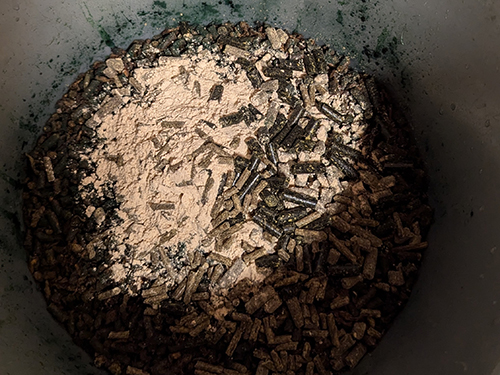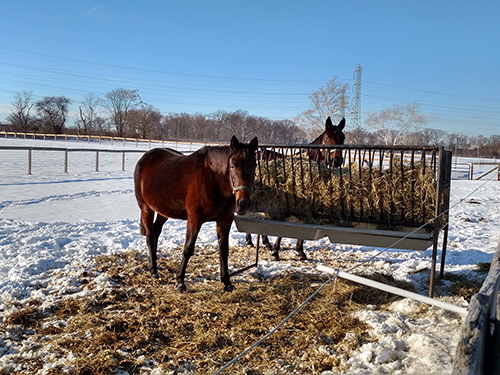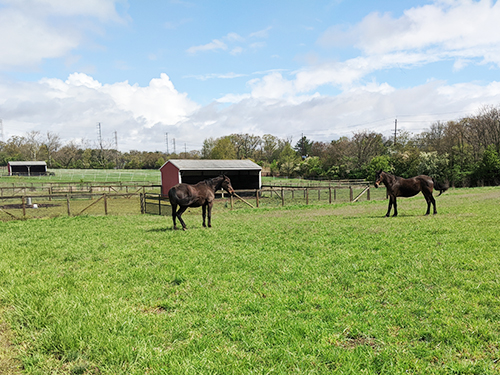
Fact Sheet FS038
Digestive System Limitations
Horses are non-ruminant herbivores and hind-gut fermenters. Their small stomach only has a capacity of 2 to 4 gallons for an average-sized 1,000-lb. horse. This limits the amount of feed a horse can take in at one time. Equids have evolved as grazers that spend about 16 to 18 hours a day grazing pasture grasses. The stomach serves to secrete hydrochloric acid (HCl) and pepsin to begin the breakdown of food that enters the stomach. Horses are unable to regurgitate food so if they overeat or eat something poisonous vomiting is not an option.
Horses are also unique in that they do not have a gall bladder. This makes high fat diets hard to digest and utilize. Horses can digest up to 20% fat in their diet, but it takes a span of 3 to 4 weeks for them to adjust. Normal horse rations contain only 3 to 4% fat; however, some high fat feed ingredients can be 20–30% for things like rice bran, up to almost 100% for vegetable oils.
An average horse's small intestine is about 75 feet long and holds about 20 gallons. Most of the nutrients (protein, soluble carbohydrates, and fat) are digested in the small intestine. Most of the vitamins and minerals are also absorbed here.
Most liquids are passed to the cecum, which is 3 to 4 feet long and holds 7 to 8 gallons. Detoxification of toxic substances occurs in the cecum. It also contains bacteria and protozoa that utilize fermentation to digest any structural carbohydrates (i.e., fiber). This microbiome will utilize the energy they consume for reproduction, but the byproducts like volatile fatty acids, and vitamin K, will be used by the horse to supply their energy and other nutrients (for more on the Microbiome, see the NJAES publication E375).
The large colon, small colon, and rectum make up the large intestine. The large colon is 10 to 12 feet long and holds 14 to 16 gallons. It consists of fourparts: right ventral colon, sternal flexure to left ventral colon, pelvic flexure to left dorsal colon, and diaphragmatic flexure to the right dorsal colon. The sternal and diaphragmatic flexures are a common place for impaction. The large colon is another cite of fermentation for the fibrous material in the diet. The small colon leads to the rectum (the last foot of intestine). It is 10 feet long and holds only 5 gallons of material and is the primary site for water absorption and where the fecal balls are made and stored.
Nutrients
Horses require six main classes of nutrients to survive. They include:

Figure 1: A horse drinking water out of an automatic waterer.
Water
Water is the MOST IMPORTANT nutrient. Horses cannot live long without it! Always make sure there is an adequate, clean supply of water. Horses generally drink about 2 quarts of water for every pound of hay they consume. In high temperatures, during hard work, or for the lactating mare, the water requirement may be 3 to 4 times the normal consumption.
Signs that your horse may be water deficient (or dehydrated) include decreased feed intake and physical activity. Signs of dehydration like dry mucous membranes in the mouth, dry feces, and decreased capillary refill (tested by placing a finger on the animal's gums and seeing how long it takes for color to return; should be 1–2 seconds) time might only appear when dehydration is severe. Probable causes of dehydration include no water source, low water palatability, or accessibility (frozen, receiving, or contaminated), or illness. Especially in the winter, it is especially important to monitor water intake to avoid the risk of colic (for more on winter feeding and care, see NJAES publications FS1142 and FS1143).
Energy
Energy is not one of the six nutrients because the horse cannot physically consume energy. However, it is a requirement for sustaining life. The densest source of energy is fat or lipids (almost three times more than carbohydrates or proteins). However, carbohydrates, in the forms of fermentable fiber or starch, are the most common source, as they are found at high amounts in almost all feedstuff that horses consume. Horses exercising, growing, pregnant in late gestation or early lactation need increased energy in their diet.
Signs of energy deficiency include weight loss, decreased physical activity, milk production, and growth rate. However, eating a diet too high in energy can cause obesity, increasing the risk of colic, laminitis, and contribute to increased sweat loss and exercise intolerance.
Fats or Lipids
Fats or Lipids can be added to feed to increase the energy density of the diet. Fat has 9 Mcal/kg of energy, which is almost three-times that of any grain or carbohydrate source. Fat is normally found at 2 to 4% in most premixed feeds. However, some higher fat commercial feeds will contain 10 to 12% fat and, if adding vegetable oil, it should be a pure fat source. See Fat Supplements section for more.
Carbohydrates
Carbohydrates are the main energy source used in most feeds. The main building block of carbohydrates is glucose. Soluble carbohydrates such as starches and sugars are readily broken down to glucose in the small intestine and absorbed. Structural carbohydrates such as fiber (cellulose) bypass enzymatic digestion and must be fermented by microbes in the large intestine to release their energy sources, the volatile fatty acids. Soluble carbohydrates are found in nearly every feed source; corn has the highest amount, then barley and oats. Forages normally have only 2 to 8% starch but, under certain conditions, can have up to 30%. Sudden ingestion of large amounts of starch or high sugar feeds can cause colic or laminitis. Some commercial feed tags now include a calculation for non-structural carbohydrates or NSC, which are the sum of sugars, starches, and fructans in a feed.
Protein
Protein is used in muscle development during growth or exercise. The main building blocks of protein are amino acids. Lysine and threonine are the first two limiting amino acids for horses, meaning they are needed in the highest amounts in the diet. Soybean meal and alfalfa are good sources of protein that contain high levels of the limiting amino acids and can be easily added to the diet. Second and third cutting alfalfa can be 25 to 30% protein and can greatly impact the total dietary protein. Most adult horses only require 8 to 10% protein in the ration; however, higher protein is important for lactating mares and young growing foals.
Signs of protein deficiency include a rough or coarse hair coat, weight loss, reduced growth, milk production, and performance. Excess protein can result in increased water intake and urination and increased sweat losses during exercise, which lead to dehydration and electrolyte imbalances.

Figure 2: Horses grazing pasture, which is high in most vitamins.
Vitamins
Vitamins are fat-soluble (vitamin A, D, E, and K), or water-soluble (vitamin C, and B-complex). Horses at maintenance usually have enough vitamins in their diet if they are receiving fresh green forage, like pasture. Some cases where a horse would need a vitamin supplement include when feeding a high-grain diet or low-quality hay, if a horse is under stress (traveling, showing, racing, etc.), prolonged strenuous activity, or not eating well (sick, after surgery, etc.).
Most of the vitamins are found in green, leafy forages like pasture grasses. Vitamin D is obtained from sunlight, so only horses that are stalled for 24 hours a day need a supplement with vitamin D. Vitamin E is found in fresh green forages, however the amount decreases with plant maturity and is destroyed during long term storage. Horses that are under heavy exercise or under increased levels of stress also may benefit from vitamin E supplementation. Vitamin K and B-complex are produced by the gut microbes. Vitamin C is found in fresh vegetables and fruits and produced naturally by the liver. None of these are usually required in a horse's diet. Severely stressed horses may benefit from B-complex and vitamin C supplements during the stress period. For more information on the use of these vitamins as antioxidants in a horse's diet, see the NJAES publication FS1065.
Minerals
Minerals are required for maintenance of body structure, fluid balance in cells (electrolytes), nerve conduction, and muscle contraction. Only small amounts of the macro-minerals such as calcium, phosphorus, sodium, potassium, chloride, magnesium, and sulfur are needed daily.
Calcium and phosphorus are needed in a specific ratio, ideally 2:1, but never less than 1:1. Alfalfa alone can exceed a Ca:P ratio of 6:1. Sweating depletes sodium, potassium, and chloride from the horse's system, therefore supplementation with electrolytes may be helpful for horses that sweat a lot. Normally, if adult horses consume fresh green pasture and/or a premixed ration, they will receive proper amounts of minerals in their diet, except sodium chloride (salt), which should always be available free choice. Young horses may need added calcium, phosphorus, copper, and zinc during the first year or two of life.
Forages
Forages are classified as legumes or grasses. The nutrients in the forage vary greatly with maturity of the grasses, fertilization, management, and environmental conditions. To determine the nutrient content in forage it is best to take samples and get them analyzed by a forage testing lab (contact your local county Extension office for testing information).
Legumes are usually higher in protein, calcium, and energy than grasses. They have more leaves than grasses and require optimal growth conditions (warm weather and good soil) to produce the best nutrients. Some legumes include clover and alfalfa. Some commonly used grasses include orchard grass, timothy, bluegrass, and tall fescue.
Hay is forage that has been harvested, dried, and baled before feeding to horses. Legume hay can contain 2 to 3 times more protein and calcium than grass hay and is usually more costly because of this. Common grass hays include timothy, brome, and orchard grass. They have fine stems, seed heads and longer leaves than legumes. They are most nutritious when cut earlier in its growth stage; nutrients like protein decrease with maturity while fiber increases.
Appearance can be a good indicator of the amount of nutrients in hay, however color should not be used as sole indicator. Good quality hays typically have higher protein, and minerals than poor quality hays. Any hay is going to be low or deficient in most minerals because when left in the sun to dry the vitamins will become denatured. Moldy or dusty hay should not be fed to horses. For more information, see Table 1 and Figures 3 and 4.
| Characteristics of Good-Quality Hay | Characteristics of Poor-Quality Hay |
|---|---|
| Low moisture content (12 to 18%) | Damp. Too much moisture causes mold |
| Green in color | Brown, yellow or weathered in color. Gray or black indicates mold |
| Sweet smelling, like newly cut grass | Musty, moldy, or fermented odor |
| Free of mold and dust | Dusty and moldy hay is unacceptable |
| Cut before maturity. Grass hays cut before seed heads mature and alfalfa cut early in bloom | Cut late in maturity. Mature seed heads and thick stems with grass hay or alfalfa cut late in bloom with more stems than leaves |
| Free from weeds, poisonous plants, trash, or foreign objects | High weed content, poisonous plants, or animal carcasses in hay bales |

Figure 3: Good quality alfalfa on the left; poor quality on the right.

Figure 4: Immature orchard grass on the left, and mature orchard grass with larger seed heads on the right.
Concentrates
Grains |
|
OatsOats are the most popular grain for horses. Oats have a lower digestible energy value and higher fiber content than most other grains. They are also more palatable and digestible for horses than other grains; however, they can be expensive. Oats can be fed whole, crimped, or hull-less; each type of processing can change the nutrient content of the oat, however, digestibility is not largely affected by processing (only 5%) and not usually worth the expense. |
Zoom in

Oats |
CornCorn is the second most palatable grain for horses. It provides twice as much digestible energy as an equal volume of oats and is low in fiber. Because it is so energy dense it is easy to overfeed corn, causing obesity. Moldy corn should never be fed—it is lethal to horses. Corn can be fed whole or processed in any way, however, typically corn in feeds is found cracked or steam flaked. |
Zoom in

Corn |
Sorghum (Milo)Sorghum (Milo) is a small hard kernel that needs to be processed (steam flaked, crushed, etc.) for efficient digestion and utilization by the horse. It is not palatable when used as a grain on its own. However, it can be used in grain mixes. Like corn, sorghum is high in digestible energy and low in fiber. |
|
BarleyBarley also has hard hulls that should be processed to allow easier digestibility. It has moderate fiber and energy content compared to oats and corn and can be a nutritious and palatable feed for horses. Barley can be used as a replacement for oats or corn when necessary. Crimped barley is pictured with whole oats. Barley is the shorter and rounder looking grain in the picture. |
Zoom in

Barley |
WheatWheat is generally not used as a feedstuff because of its high cost and low palatability. Its small hard kernels should be processed for horses to digest. Wheat is higher in energy than corn and best used in a grain mix or as it by product, wheat bran (pictured). |
Zoom in

Wheat |
Protein Supplements |
|
Soybean MealSoybean meal is the most common protein supplement, which averages around 44% crude protein. The protein in soybean meal is usually a high-quality protein with the proper ratio of dietary essential amino acids and higher levels of the limiting amino acids. |
Zoom in

Soybean Meal |
Cottonseed MealCottonseed meal (48% crude protein) and peanut meal (53% crude protein) are not as common for horses as soybean meal but could also be used if a protein supplement is needed. |
Zoom in

Whole Cottonseed |
Brewer's GrainsBrewer's grains (the mash removed from the malt when making beer) are a byproduct of the brewing industry. It is nutritious and palatable with about 25% crude protein and is also high in fat (13%) and B vitamins. When considering using brewer’s grains in a ration is it recommended to get an analysis of the nutrients as they can be quite variable. |
|
Fat Supplements |
|
Vegetable OilVegetable oil is the most commonly used fat source in horse feeds. If adding the oil supplement as a top dress to feed for increase calories start with a quarter cup and increase to no more than 2 cups per day over the course of 2 weeks for the average size horse (1,000 lb). |
|
Rice BranRice bran is a fat supplement that is distributed by most commercial feed dealers, it consists of about 20% crude fat, giving it an energy content of 2.9 Mcal/kg (or 1.3 Mcal/lb). Rice bran is highly palatable and is a great addition to a ration for a horse that needs more calories but does not like the oily consistency when vegetable oil is used. Rice bran in its raw form (i.e., directly from the rice factory) can be deficient in calcium, however, most commercial feed companies have made stabilized rice bran that is fortified with calcium and will not get rancid as quickly. |
Zoom in

Rice bran |
FlaxseedFlaxseed is not technically a grain but a seed, it is about 42% fat and is commonly used to feed horses because of its high Omega-3 fatty acid profile. About 50–60% of the fat it contains is in the form of Omega-3s. Flaxseed can be fed whole, or ground, however, if feeding it ground it has a shorter shelf life and therefore should be stored in an airtight container in a cool dry storage area. |
Zoom in

Flaxseed |
Feeding Guidelines
- Forage is the base! Always try to feed the most forage possible then add concentrate. Keep forage at no less than ¾ of the total ration.
- Feed at a rate of 1.5 to 2.5 % of the horse's body weight (1000 lb horse = 20 lb in total feed per day).
- To maintain body weight, most horses need only good forage, water, and a mineral block.
- Feed by weight not volume!
**A 1 lb. scoop of Oats does not equal 1 lb. of Corn** - Horses have small stomachs so concentrates, if used, should be fed no less than twice a day.
- Store feed properly: it should be kept free of mold, rodents, or contamination.
- Keep Ca:P ratios around 2 parts Ca to 1 part P. Calcium should never be fed at a rate less than phosphorus.
- Feed on a set schedule (horses are creatures of habit and are easily upset by changes in routine).
- Change feeds gradually (horses' hindgut microbiome cannot cope with drastic changes in feed; could cause colic).
- When work or exercise decreases, decrease the grain portion of the ration.
- Be aware of the pecking order in your horse's pen—are they getting their feed? If not feed them separately.
- Examine teeth at least once a year to make sure they can chew feed.
References and Supplemental Reading
- National Research Council. 2007. Nutrient Requirements of Horses. National Academy Press, Washington, DC.
Photo credit: C. Williams, Equine Extension Specialist, Rutgers University
September 2024
Copyright © 2025 Rutgers, The State University of New Jersey. All rights reserved.
For more information: njaes.rutgers.edu.
Cooperating Agencies: Rutgers, The State University of New Jersey, U.S. Department of Agriculture, and Boards of County Commissioners. Rutgers Cooperative Extension, a unit of the Rutgers New Jersey Agricultural Experiment Station, is an equal opportunity program provider and employer.



